Laser hair removal - At a glance
Top Questions
Laser hair removal Overview
Excess facial and body hair is due to hereditary factors and hormonal events such as puberty, pregnancy, menopause and other hormonal conditions like PCOS. Due to this, no laser treatment can ever guarantee 100% permanent hair removal.
There are two types of laser hair removal options available to clients:
Laser uses a concentrated beam of a specific single wavelength of light, adjusted to the colour of the hair being treated and the skin tone of the individual. They target the melanin pigment in the hair follicle and leave the surrounding skin undamaged. Many people have experienced dramatic and significant permanent hair reduction following laser hair removal.
IPL (Intense Pulsed Light) uses multiple wavelengths (500nm - 1200nm) of light that scatter within the skin, heating it up. It is a cheaper, less effective hair removal technology. IPL has a variety of uses in treating other skin conditions like superficial pigmentation, rosacea and fine blood vessels.
Due to the reduced efficacy of IPL, this guide concentrates instead on true laser hair removal.
The laser hair removal Glowday Treatment Guide has been guest edited and medically verified by Roisin Hopkins.
How does laser hair removal work?
Hair grows in stages:
- Anagen stage - The active, growing stage of the hair follicle.
- Catagen stage - The intermediate period of hair growth.
- Telogen stage - The resting or shedding stage.
Laser hair removal targets hairs in the anagen stage, when the root of the hair has a good blood supply and is firmly bedded in the follicle. When you pull these hairs out, they have a jelly-like bulb at the root. At any one time, 20% - 40% of the hairs on your body are in this stage.
The laser machine is set to a specific wavelength, depending on your hair colour and skin tone. Laser hair removal is not effective on very blonde or red hair. Whether you are a suitable candidate for laser hair removal will be determined by the Fitzpatrick Test.
Dark pigments (melanin) in the hair absorb the light from the laser, which turns to heat. If the hair is firmly rooted into the follicle (is in the active stage), the heat inflicts intentional damage on the hair cells, ideally causing them to die.

The affected hairs eventually fall out and don’t re-grow. Those which weren’t in the anagen stage continue to grow, which is why multiple (6-12) laser treatments are recommended, targeting all follicles.
Who is a good candidate for laser hair removal?
Laser hair removal is used to significantly reduce hair growth by up to 90%.
It is predominantly used to treat unwanted body hair. Typical areas include, upper lip, underarms, bikini line, legs and arms.
The ideal candidates for laser hair removal are those with very fair skin and very dark, coarse hair. Those with red, blonde, grey, or white hair and those with very fine hair, aren’t suitable for laser hair removal. Instead, electrolysis would be a good alternative.
Laser may not be suitable if you have darker skin tones. This is due to the melanin in the skin absorbing the energy from the laser, rather than it targeting the pigments in the hair. This could lead to hyperpigmentation (darkening of the skin). Some practitioners are highly experienced in treating those with darker skin tones using a specific laser called a Nd:YAG. They will spot test your skin to determine your suitability.
Laser is not suitable if you:
- are pregnant or breastfeeding
- are on or have recently finished a course of isotretinoin medication in the last 6 months
- have an active infection in the area to be treated
- have a known sensitivity to light
- are taking St John's Wort
Laser may not be suitable for those with photosensitive epilepsy.
How do you prepare for laser hair removal?
Prior to your treatment, you'll need to avoid tanning the area to be treated. This means sun exposure and the use of tanning beds should be avoided 4-6 weeks before treatment. You should also avoid the use of false tanning products. You need your skin to be as pale as possible for the treatment to be most effective.
The area you are having treated needs to be hair-free, with the root of the hair in place. This means that you should shave the area prior to the day of your treatment, ideally the day/night before.
Waxing, sugaring, threading, plucking, epilating and hair removal creams should be avoided, as this removes the hair at the root.
On the day of your treatment, avoid applying moisturiser, makeup or deodorant to the area to be treated.
Your laser hair removal treatment
Step One - Consultation and Consent
On arrival at the clinic, your practitioner will complete a detailed personal details and medical history form with you.
They will discuss your medical history and clearly highlight the realistic, expected result of the treatment.
Step Two - Your Laser Hair Removal Treatment
The laser machine will be set to the correct wavelength, determined during your consultation.
You and the practitioner (and anyone else in the room) will be given a pair of dark goggles to wear.
What should you do after laser hair removal?
You may find that the treated area feels warm for around 24 hours after your treatment, so avoid hot showers and baths and apply a cooling aloe vera gel if necessary.
Avoid thick and heavily perfumed products for a few days.
You may want to wear looser fitting clothes on the day of your treatment, to avoid aggravating treated skin.
It is important that, between treatments, you rely only on shaving to remove hair. Waxing, sugaring, threading, plucking, epilating and the use of hair removal creams should be avoided.
Stay out of the sun and use a high protection factor sunscreen (at least SPF30) if you do go out in the sun.
Contact your practitioner if you experience prolonged discomfort, the area becomes infected or blisters.
What are the side effects and risks of laser hair removal?
In the correct hands, laser hair removal is a minimally invasive procedure with little discomfort.
Immediately following treatment, the skin in the treated area may become pink and sore, a bit like mild sunburn. However, this should not persist.
Rarely, skin can become temporarily lightened. In some cases, this can last for a few months.
Very rarely, melanin in the skin absorbs the energy from the laser, instead of/as well as the pigment in the hair. This can result in blistering and scarring.
How much does laser hair removal cost?
Laser hair removal is usually charged per area, areas are packaged together, or repeat treatments are packaged together at a discounted price.
- Extra Small Area (e.g. Upper lip) from £40
- Small Area (e.g. Underarms) from £50
- Medium Area (e.g. Classic bikini) from £70
- Large Area (e.g. Half arms, Brazilian bikini) from £100
- XL Large Area (e.g. Half leg, Hollywood bikini) from £130
- XX Large Area (e.g. Full legs) from £199
Example package:
Women’s Package (Brazilian bikini, underarms, half arms and full legs)
- Single treatment from £430
- 4 x treatments from £1200
- 8 x treatments from £2060
Glowday Disclaimer
All information in our Glowday Treatment Guides and blog articles is intended for reference and information. The information given here is to help you make informed decisions when considering the wide range of non-surgical aesthetic treatments available.
It is NOT intended as medical advice. Any reliance placed by you on the information contained within the Glowday Treatment Guides, Glowday blog articles or on any of Glowday.com is done by you at your own risk.
Before undergoing any non-surgical cosmetic treatment mentioned anywhere on Glowday.com, you should fully consult with an appropriately qualified and accredited practitioner who is properly trained in and fully insured to conduct the treatment you are interested in. Neither the author of the guides or blog articles, or the practitioner who has verified the guides nor Glowery Limited can be held responsible or liable for any loss or claim arising from the use or misuse of the content of Glowday.com.

